#Dungeons and Dragons 1e
Explore tagged Tumblr posts
Text

Relgar the Bloodied and Indil have consumed my every waking thought and I cannot escape them even in my messy ass sketches.
#is this even possible#my self shipping has become so convoluted I’m now consumed by Eddie’s oc and my oc#I can’t#help me lord#admin art#stranger things#stranger things rise of hellfire#rise of hellfire#Eddie Munson rise of hellfire#Relgar the Bloodied#advanced dungeons and dragons#dungeons and dragons 1E
8 notes
·
View notes
Text
D&D and Pathfinder RPers tell me what you think.
#pathfinder#pathfinder 2e#pathfinder 1e#pathfinder monsters#dungeons and dragons 3.5#dungeons and dragons 3.0#Dungeons and Dragons 1e#Dungeons and Dragons 2e#Dungeons and Dragons 4e#Dungeons and Dragons 5e#D&D#advanced dungeons and dragons#d&d monster#d&d 5e#d&d 3.5#d&d homebrew#D&D 1e#D&D 2e#D&D 3.0#D&D 4e#hags
5 notes
·
View notes
Text
These are available in August!
#stamp collecting#stamps#usps#ad&d 1e#dungeons and dragons#ttrpg#d&d#old school renaissance#osr#ad&d#dnd5e#dnd#dnd1e#d&d 5th edition#d&d 5e#collectibles#d&d art#dnd art
601 notes
·
View notes
Text
Dohwar

[I would just like to take a moment to thank @thecreaturecodex for bouncing ideas off and proofing this entry, I am thankful for her help.]
Dohwar This small penguin-like humanoid sports a glossy black and white feather coat with a colorful brow feathers.
Dohwars are a race of small, chubby, flightless avian resembling in many ways large penguins. Native to temperate and arctic coastal regions of a far off world, they are consummate merchants, viewing most interactions through a lens of mercantile exchange and contract. A dohwar refers to marriage partnership as a "merger" and their eggs as "new wares." A dohwar is constantly seeking new means of barter and exchange, a trait that either makes them endearing or grating depending on the individual dealing with the dohwar. Dohwar tend to loath violence, viewing it as a complete dissolution of ability to negotiate with others, but in case of the inevitable, prefer a support role, leaving combat to allies or mercenaries when combat arises.
Dohwar as player characters A dohwar does not have racial Hit Dice and advances by character class. Bard, Occultist and Rogue are common classes among dohwars. A dohwar character has the following racial traits-
+2 Intelligence, +2 Charisma, -2 Wisdom: Dohwar are shrewd and charismatic negotiators, but are known to be flighty and impulsive.
Small: Dohwar gain a +1 size bonus to their AC, a +1 size bonus on attack rolls, a –1 penalty on combat maneuver checks and to their CMD, and a +4 size bonus on Stealth checks.
Slow Speed: Dohwar have a base speed of 20ft. They also have a swim speed of 30 feet and gain the +8 racial bonus on Swim checks that a swim speed normally grants.
Humanoid (Dohwar): Dohwar are humanoids with the dohwar subtype.
Dohwar Telepathy: A dohwar is able to mentally communicate with any creature within 30 feet with whom she shares a language. Otherwise this ability is identical to the telepathy ability.
Hold Breath: Dohwar can hold their breath for a number of rounds equal to four times their Constitution score before risking drowning or suffocating.
Mercantile: Dohwar receive a +2 racial bonus to Appraise and on a Craft or Profession skill of their choice. Dohwar also always have Appraise and Sense Motive as a class skill.
Psychic Attunement: Dohwar receive Empath as a bonus feat at 1st level. Those who can’t use occult skill unlocks at 1st level instead gain the Psychic Sensitivity feat as a bonus feat.
Alcohol Immunity: Dohwar are immune to the effects of alcohol and alcohol addiction, however, glucose, such as found in fruit and honey, affects her in a manner similar to strong wine or beer.
Language: Dohwar begin play speaking Common and Dohwar. Furthermore, members of this race with high Intelligence scores can learn any languages they want (except Druidic and other secret languages).
#dohwar#pathfinder rpg#pathfinder 1e#pathfinder#dungeons and dragons#spelljammer#humanoids#playable race#pathfinder homebrew#homebrew race#homebrew
27 notes
·
View notes
Text
3.5 to PF1e Conversion: Waterveiled Assassin
Welcome back! This is a conversion I've honestly been eager to do someday.
Back in the good old 3.5 days, there was this evil god, Tharizdun, who was basically like a previous version of Rovagug, in that it just wanted to wreck everything and had suckered the four evil Archomentals (Ogremoch, Yan-C-Bin, Imix and Olhydra) into working for his agenda. Each evil Archomental had some favored avatars for carrying out their will, which were appropriately called Avatars of Elemental Evil.
Since I liked those creatures well enough, and I thought they can easily be incorporated in the Golarion setting with only a few changes... I'd like to try my hand at converting them, starting with the Waterveiled Assassin. Enjoy, and please let me know what you think and where I can improve!
WATERVEILED ASSASSIN

Image (c) Wizards of the Coast, from Monster Manual IV, author Daarken
Before you stands a monstrous, vaguely serpentine shape made of water, with hateful eyes and a mouth turned into a wicked sneer barely visible in what passes for its face.
WATERVEILED ASSASSIN CR 15
XP 51’200
NE Large Outsider (elemental, evil, extraplanar, water)
Init +12; Senses darkvision 60 ft., Perception +22
DEFENSE
AC 28, touch 17, flat-footed 20 (+8 Dex, +11 natural, -1 size)
hp 225 (18d10+126); fast healing 5
Fort +18, Ref +19, Will +12
Damage Reduction 10 / -; Immune elemental traits
OFFENSE
Speed 30 ft., swim 60 ft.
Melee 2 slams +25 (4d8+8 plus grab)
Space 10 ft.; Reach 20 ft.
Special Attacks churn, drench, engulf (DC 27, 4d8+12), grab, water mastery
STATISTICS
Str 26, Dex 27, Con 24, Int 10, Wis 19, Cha 15
Base Atk +18; CMB +27 (+31 grab); CMD 45
Feats Cleave, Combat Reflexes, Engulf Revulsion, Great Cleave, Improved Initiative, Iron Will, Lunge, Power Attack, Skill Focus (Stealth), Vital Strike
Skills Acrobatics +22, Bluff +16, Intimidate +16, Knowledge (planes) +16, Perception +22, Sense Motive +20, Stealth +32, Swim +36
Languages Aquan
Special Qualities liquid body, malleable form, one with water
ECOLOGY
Environment any (Elemental Plane of Water)
Organization solitary
Treasure standard
SPECIAL ABILITIES
Churn (Ex): As a swift action, a waterveiled assassin can batter opponents it has engulfed with mighty currents that it creates by controlling its own shape. All creatures currently engulfed within the waterveiled assassin’s body take 4d8+12 points of bludgeoning damage as the currents try to tear their bodies apart. A successful Fortitude saving throw (DC 27) halves the damage taken. The save DC is Strength-based.
Drench (Ex): The waterveiled assassin's touch puts out nonmagical flames of Large size or smaller. The creature can dispel magical fire it touches as dispel magic (caster level 15th).
Liquid Body (Ex): A waterveiled assassin exercises supreme control over its watery form, allowing it to flow around attacks, flatten itself against the ground to avoid a spell’s blast, and so forth. Any effect or spell that allows a Reflex save for half damage has a 50% chance to have no effect on a waterveiled assassin. Even if it is affected, the waterveiled assassin can still attempt a saving throw against the spell’s effect as normal. This ability also gives the waterveiled assassin a greater reach on its melee attacks, effectively increasing its natural reach to 20 ft.
Malleable Form (Ex): A waterveiled assassin’s control overits form allows it to flow through tiny cracks in objectsand move through the earth, walls, and other obstacles.The assassin moves at normal speed through terrainthat slows movement. It can move through permeable objects at half speed, but it cannot move through completely solid barriers, such as those produced by a wall of stone or wall of force spell.
If a waterveiled assassin ends its movement completely within an object, opponents do not have line of sight or line of effect to it. Its reach drops to 0 feet. Any creatures engulfed within the assassin automatically break free of the grapple and fall prone in a square adjacent to the object. If only part of the assassin is in an object, but its remaining space cannot hold all the creatures within it, the assassin may choose which ones to release.
One With Water (Ex): A waterveiled assassin that is completely immersed in a volume of water that’s at least 15 ft. wide, 15 ft. long and 15 ft. deep is effectively invisible, as per the greater invisibility spell.
Water Mastery (Ex): A waterveiled assassin gains a +1 bonus on attack and melee damage rolls if both it and its opponent are touching water. If the opponent or the waterveiled assassin is touching the ground, the assassin takes a –4 penalty on attack and melee damage rolls. These modifiers also apply to bull rush and overrun maneuvers, whether the assassin is initiating or resisting these kinds of attacks.
A waterveiled assassin is a creature of living water sent by Kelizandri, the evil Elemental Lord of Water, to slay his cult’s enemies. This deadly killer can flow through the smallest cracks to ambush and engulf foes, and its fluid form and mastery of water lets it strike at opponents from unexpected angles.
The waterveiled assassin is a canny hunter, making use of terrain advantage and of all their special abilities to surprise foes and dispatch them quickly. A waterveiled assassin has no use for a fair fight; it usually approaches its target in open water, taking advantage of its invisibility, or hides within a wall or a large non-waterproof object that can contain its bulk. When its target closes, the waterveiled assassin surges forth, rolling over its foe and trying to drown him or batter him to death in its liquid body. A waterveiled assassin usually focuses on the least armored foes, knowing they are more likely to be arcane spellcasters or to have dangerous abilities, and drags them off to an isolated spot for the kill.
If a waterveiled assassin has a weakness, it is overconfidence – an assassin might leap on a party’s wizard or sorcerer while disregarding physically capable combatants, and giving them the chance to heap severe punishment upon the elemental.
A waterveiled assassin’s form is unstable, but it usually stands about 12 feet tall and weighs 1'000 pounds.
#conversion#d&d 3.5#pathfinder 1e#elemental#outsider#dungeons and dragons#waterveiled#assassin#tharizdun
22 notes
·
View notes
Text

Lariwen Chibis, because I never uploaded all the shipping art I made of them way back when we first started playing Pathfinder in the early 2010s. Lartriel the Drow Sorcerer and Eriwen the Snow Elf Oracle.
#dungeons and dragons#ttrpg#dnd#pathfinder#pathfinder 1e#drow#snow elf#digital art#my art#theixwynart
7 notes
·
View notes
Text

pathfinder game restarted, and I got to rework some things with Lokee and wanted to illustrate a bit of it!
he has cool mind reading powers now!
#tiefling#pathfinder 1e#dungeons & dragons#ttrpg art#AJ Arts#Lokee#dnd#d&d#I worked on this all night and all morning and started it a few days ago#oogh I'm pretty happy with the result though
17 notes
·
View notes
Text

For Comparison:
In Pokemon, when you are paralyzed, you have a 25% chance to be unable to act on your turn and your speed is lowered by 50% (speed only determines who acts first, and not number of actions, so it's not too bad).
In D&D 5E, paralysis prevents you from moving or acting, you automatically fail strength or dex saves, attacks against you have about 20% more accuracy, and melee attacks against you automatically crit (if they hit).
In Pathfinder, paralysis also prevents you from moving or acting, and you are considered 'helpless'. Helpless means your dexterity is 0 (tanking your evasion) and in addition melee attacks against you get a +4 to hit (equating to a 20% increase in chance to hit). More importantly, though, if someone is adjacent to you they can make a coup de gras attack. A coup de gras is an automatic hit, an automatic crit, and then the character must make a fortitude save of 10+damage dealt to not instantly die (this is often very difficult, nearly impossible if the coup de gras was done by an actual fighter).
#pokemon#D&D 5e#dnd 5e#dungeons and dragons#pathfinder#pathfinder 1e#meme#humor#video games#videogames#ttrpg#tabletop rpg#tabletop roleplaying game
23 notes
·
View notes
Text

A wyvern (pronounced: /ˈwɪvɜːrn/ WIH-vurn or: /ˈwaɪvɛrn/ WY-vern) was a large winged lizard, distantly related to the dragon, with a poisonous stinging tail and sharp teeth.
These creatures varied in length from 15 to 35 feet (4.6 to 11 meters), weighed around a ton, and were covered in dark brown or grey scales. They typically had either red or orange eyes and their jaws were filled with long and sharp teeth.
Unlike true dragons, wyverns only had a pair of hind legs instead of a set four. Their wingspan could get over 50 feet (15 meters) in length. And their tails were often quite long, comprising almost half of their bodies, yet very mobile. These ended in a thick cartilage knot with a stinger protruding out of it, not unlike that of a scorpion.
Wyverns can be both solitary and group animals. They did not have a strong odor, although their lairs often could be tracked by following the smell of their recent kills.
Cloud giants kept griffons, perytons, and wyverns, akin to what humans did with hawks and other birds of prey. These tamed wild creatures could also be often encountered patrolling the cloud giants' gardens, together with other tamed predators like owlbears.Dragons, griffons, and wyverns had a fierce rivalry over hippogriff meat. Manticores, chimeras, griffons, perytons, and wyverns were territorial rivals.
Source: https://forgottenrealms.fandom.com/wiki/Wyvern
Have you added wyverns to your game? Talk to us about it!
21 notes
·
View notes
Text
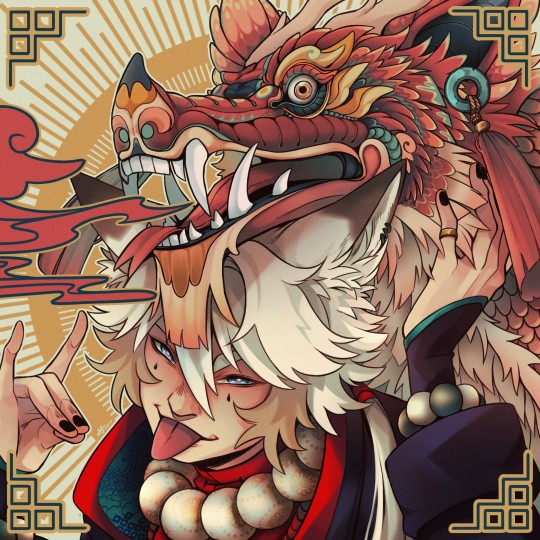
Some late little lunar new year piece with Lixin
#lixin#pathfinder 1e#my art#my art and animations#dnd#dungeons and dragons#dnd5e#oc#dnd character#dnd art#pathfinder#pathfinderrpg#kitsune#fox#dragon#lunar new year
36 notes
·
View notes
Text

My Ancient India campaign setting is live on Kickstarter!
This setting features 6 new races, a plethora of historical weapons and armor, 20+ monsters inspired by Indian folklore, and much more.
Check it out here.
#dnd#d&d#pathfinder#tabletop#ttrpg#dndart#cartography#5e#pathfinder 1e#dnd homebrew#dnd stuff#dungeons and dragons
22 notes
·
View notes
Text
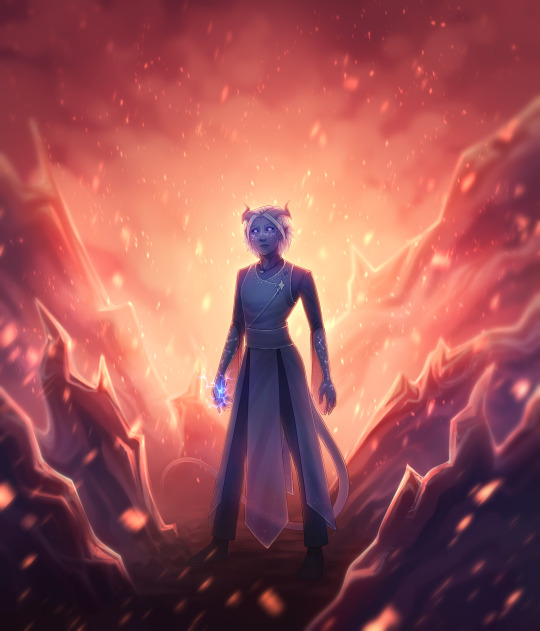
“You think that I’m weak because I wasn’t trained like you. You’re going to regret underestimating me.”
Some post-campaign stuff with Seren ✨
32 notes
·
View notes
Text
#elves#tolkien elves#lotr elves#dark elves#dnd elves#high elves#elf#warhammer 40k#warhammer fantasy#warcraft elf#world of warcraft#house elf#house elves#harry potter#ad&d 1e#ttrpg#d&d#dungeons and dragons#d&d polls#ttrpg polls#polls
451 notes
·
View notes
Text
No. 9 - T1, The Village of Hommlet (August 1979)
Author(s): Gary Gygax Artist(s): David A. Trampier (Cover), David C. Sutherland III Level range: 1 Theme: Tutorial dungeon Major re-releases: T1-4 The Temple of Elemental Evil, The Village of Hommlet (2009), Original Adventures Reincarnated #6.
CW: Discussion of Antisemitism. I didn't see that coming.
Possibly the end of the hiatus curse? Since then, I had further brainworms and acquired (and read) the fiend folio, the MM2, several Jon Petersen histories on TSR and the industry, and more. Will this reflect in the review itself? Maybe!
...Wait, there's a 4e version? 4e had a really weird habit of random 1e remakes didn't it? It was a reward for WOTC's organized play DMs, I have not read it in its entirety but it is very revisionist in a bad way. It's jarring, it mashes up 4e-style art with the original black and white pen-drawn art of 1e and also greyscale realistic maps? It's a mess of a release and there's some truly weird retcons in it. Anyway, we're here for 1e, not 4e.
Actually, one more aside. There is an adventure sequence called The Great Greyhawk Campaign. It was never officially announced or released as one product, but the idea goes that you start in Hommlet, you go to the Temple of Elemental Evil, you do the Slavelords campaign, then the Giants sequence, then the Drow sequence, and finally wrap in Q1. That's a hell of a ride, and it would probably comfortably get you to level cap for most characters. I really wanna try it some day, but I can't imagine it ever happening (that is SO long!)
So. T1. How do you start with T1?
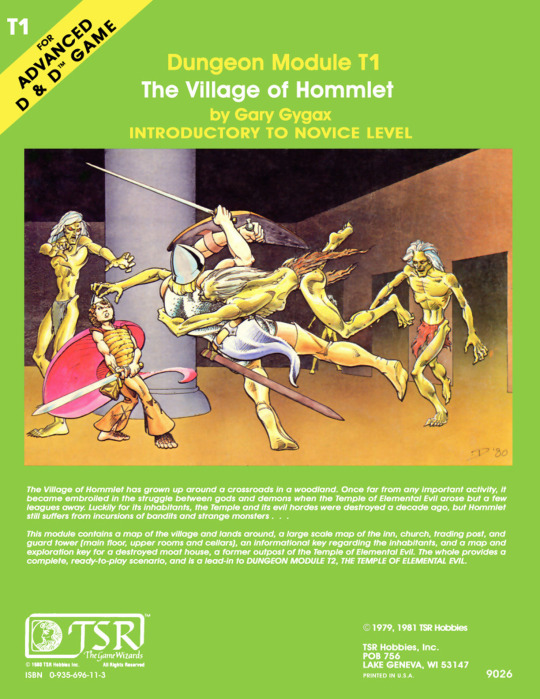
I think you can seriously argue that T1 is the single most reviewed module of all time. It honestly feels a little excessive to cover it. And yet, I felt obligated to do my dues to T1. Why?
Because T1 is, more than any previous module, the most influential module ever made. Lots of early modules are influential. G1 is important for being the first standalone module. D2 is important for being an early module to not assume hostilities. B1 is the first tutorial dungeon. But the thing about all of those is that in 2025, those types of modules have dramatically moved on. T1 remains the same. T1 is the granddaddy of all starter towns in every video game and every ttrpg. Every starter town is being compared against T1, it is the baseline.
Now this is not to say that T1 is perfect, or that T1 has aged like fine wine. But T1 tapped into something elemental about D&D that it needed to progress. Prior to T1, many parties simply...didn't play out the out-of-the-dungeon part. Characters poofed into the dungeon entrance and poofed out because the game was about dungeoncrawling. T1 represents a wildly different vision for the game, one that Gary and friends had been doing for a while and many people had independently dreamed up, but T1 made it standard that there was a nearby town that you actually went to and played things out, that was your home base. D3 was still, ultimately, a hostile environment. Like look at this:
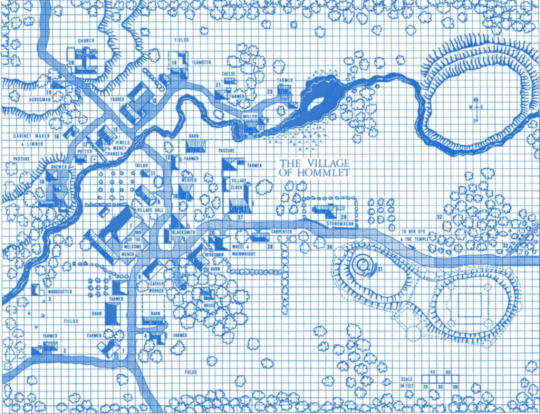
That's just what DND towns look like. This basic structure (a town with a mayor and farmers and shopkeeps and blacksmiths and the local wizard and a dungeon nearby) is ubiquitous in DND now. You can basically describe any given dnd starting town as Hommlet And BLANK. Orlane is Hommlet And Kidnappings. Phandelin is Hommlet And Miners. Shadowdale is Hommlet And Wizards. Saltmarsh is Hommlet And Smugglers. It's hard to even get across how little has fundamentally changed between T1 and the 2014 Starter Set. Really if one thing has "changed" between T1 and then, it's the belief that adventures SHOULD have narrative hooks and SHOULD have an overarching plot. Even then they sometimes skip those.
Despite it's influence, T1 is weird in that it feels less like a module and more like a game aid. At its core, Hommlet is a town that has nothing to do with the nearby dungeon, and a dungeon that has nothing to do with the town. The town is keyed like a dungeon, and the dungeon is keyed like...a dungeon. The connective tissue is that the Temple of Elemental Evil is lurking as a threat behind everything, but T4 won't be released for QUITE some time, so it feels vague and distant. We get an actually surprisingly sophisticated history lesson: Hommlet was founded as a travel inn, a blacksmithy, and some farms. It grew into a proper town. Things got bad when their neighbors in Evil Town decided to Worship Evil and did Evil Stuff to them. The forces of good rallied and killed the bad guys, sieging the Temple of Elemental Evil and locking the evil inside. Adventurers slowly dried up as the area ran out of adventure to adventure at. So now evil returns and you lot will bumble into it.
Let us, then, get into the town part of the key.
One of the cliches of old TSR towns, to me, is that item #1 is always a farm. The game always presumes you enter town and you find a farm and the family is there and they wave at you. Orlane inverts this a bit by having the farmers NOT happy to see you, which is one of the many reasons I consider Orlane to be the most interesting starter village ever.
At this point time, thieves are a class now, and so (conspicuously) everything is marked for how the players could rob it.
There are a lot of what you might call "empty hooks" lying around town. For example, the son of a local farmer is actually a spy for Verbabonc (SUCH a TSR name) that will help you if paid to, and if he dies his brother will demand restitution. Why? That's left to a later module! Which wouldn't come out for another 6 years! Oops!
The wealth amounts in this town are genuinely unhinged, as usual. Inside a crock in some cowshit is, for some reason, nearly 700gp of treasure. Would you go digging around in cowshit for 70 dollars? Maybe if I had gloves. The placements are all nefariously difficult here: "sewn inside a horsecollar" do kids even know what horsecollars are anymore? Do they know who Horace Horsecaller is? How old are we!
A frankly annoying quality here is that these buildings are keyed with the first appearance in ALLCAPS followed by the actual building title in the body paragraph -- The Inn of the Welcome Wench is buried 3 lines into its text. You're not gonna skim that. You have to know in advance where it is, basically. The inn itself is, inexplicably, keyed separately without calling out that the actual room-by-room is elsewhere. If you scroll forward to page 9 (possibly looking for the map, which is also housed elsewhere), The contents of the inn itself is fairly ho-hum, it's a normal inn with many normal recruitment opportunity and the obligatory gygaxian traitor henchmen (who are unfailingly higher levels than their non-traitor peers). A few specialties are here though: a secret room from the old resistance, a spy from the temple of elemental evil, a secret ceiling compartment where druids can spy on suspicious guests).
A cavalcade of repetitive cottagers follow, emphasizing why in the future we stopped keying every single house. Many are not named, with that classic "so you customize it" excuse that people love trotting out. It does serve the purpose of making sure you have an answer to exactly who is with which faction: The Cuthbertites, the newbie; The Grove, part of the old alliance; the Temple, Verbabonc, the big supporter of the alliance; or one of the few neutrals.
The trader's establishment is also lovingly given a map and keys. Curiously, it is for lack of a better phrase "sub keyed", where the main room has every single item in it given a location. The map is here mainly because the players might discover the traders are also spies and want to kill them. They probably won't succeed, it's a Lv10 thief and a Lv7 assassin, they will at best cause them to flee and at worse die in the process.
I always find it funny how "moneychanger" is a perpetual occupation in DND. I have no idea how common historical moneychangers were, but if DND is to be believed, there's one in every podunk town. What do they do for the majority of the year when it's not market day?
For reasons I cannot fathom, they finally call out the separate map and key for the church after skipping every other keyed location. It's a standard fantasy church, styled after a catholic one, with the bit that Cuthbert is a brute and likes beating his worshippers into compliance. It's trying very hard to be funny but I'm not sure how funny it'd be to any table I've run. Why precisely this needed a room by room map is unclear to me, I can't foresee why you'd fight there. The walled manor is not keyed, despite being the official holdout if the temple attacks.
A half-built castle is underway for the town's old heroes, Burne and Rufus, who are mid level adventurers who have settled down. They live next door in the tower, which gets its own key, though there's not much to report beyond "it's a guard tower." Really, the main advantage of T1 as a document is that it has maps for your default buildings: a town, an inn, a trader's shop, a guard tower, and a dungeon. The maps are probably worth more than the keying for the purposes of the neophyte GM.

It is truly the town-est town ever to have town'd. Its genericity means you really could just put it in any faux medieval fantasy setting anywhere.
Nothing's really driving you to the main dungeon, that moathouse, in fact it never directs you to mention the moathouse from any specific NPC. You either work it in or the players need to wander around and explore it for simply being there -- like you're playing a TES game. In fact, not much of this book's setups really fire off anything else. There are a few people who will tail you into the dungeon or betray you if you hire them to go in with you, but that's pretty much it. All the actual secret going on in this town is immaterial to T1, setting up for T4? But let's talk about the moathouse.
First of all, I just adore the bad guy's name. "Lareth the Beautiful." They really don't make NPC names like they used to. A good title after a first name -- even just a place of origin name (Bridgette of Freeport) starts implying things about the world that are far more interesting that Jane Silvercat. A pox on noun-noun names! It's almost a shame Lareth will probably die here because he begs to be put to greater use! In any event, the Moathouse is a shithole. Just look at this mess:
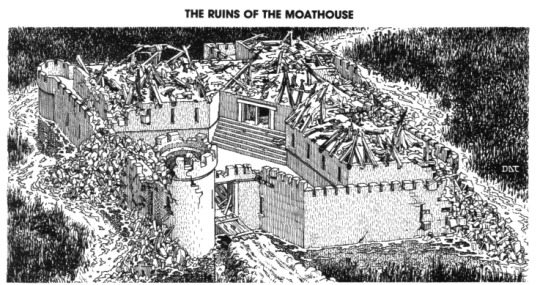
Your first instinct when you're reading about the new castle is "why don't they just repair the moathouse?" and you see this mess and you go "oh yeah that makes sense." There's not much to say: it's a moathouse the Temple of Elemental Evil built as an outpost. It got destroyed when the Temple got shut down by the big alliance, and now it's despised and destroyed. It's faintly defiled land. Really the weird thing is that it's a full hour away in a marsh. I will spare you the Monty Python bit.
Going into the keying now:
The random table is interesting in that half of the encounters are actually not encounters at all, but rather random happenings. It's a messed up castle so it's echo-y and there's rats and it's still in the process of falling down.
There's something so simple about being jumped by frogs at the front gate. I always love the "drag the player by the frog's tongue" moment and I use it often in my own games.
This dungeon is working hard to communicate how messed up it is. Even the floor will give in on your mount, laming them. Mercifully, there's a chance of discovering bootprints to confirm you're not alone.
The bandits inside have a solid escape plan, and will use it if you look scary: bar the door and run through the hole in the wall into the marsh. It's nice to see clever bandits sometimes.
Not unlike Saltmarsh later, the top level is mostly deserted. It exists to get you off guard for the actual danger in the dungeon level. Physically accessing the basement is fairly easy, there is 1 access that you simply walk into from the big room, although a sister staircase gives you further reason to look for it.
The bottom level, by comparison, is just very stereotypically dungeon-y. There's torture chambers, miscellaneous monsters there through hiring or chance, torture chambers, et c.
The false door trap is so beautifully simple that I'm a little surprised it hasn't made more returns. Essentially a common door that, when opened, closes a portcullis behind the door and reveals a dead end on the other side. It's basically just a loud cage snapping shut. So many traps make no sense but this one is surprisingly simple: it's a gravity powered trap, controlled by a disguised winch elsewhere.
Tragically, Lareth's ambitious do not get much detail. He's the new hope of the Elemental cult but how or why he does this is not clear, just that he's underhanded and clever.
A strange and gross final note to end on: one of his pieces of loot is a phylactery, but not in the Lich sense -- it's an amulet-amulet. That you wrap around a cleric's arm. In fact, Lareth is specifically wearing it on his left arm, which strongly implies he's right-handed. I think this because, when Jewish folks wear real-life phylacteries, they wrap them around their non-dominant arm, and another around their head. Wait, so we have an evil cleric leading a secret cabal that is opposing a catholic saint by spying and infiltrating a community and leading monsters against them, and he is explicitly duplicitous and a talker and underhanded and greedy and in league with a demoness. The fact that Laerth is wearing the phylactery correctly implies that Gary knew exactly what it was. Gary, why did you strongly imply the evil cleric in charge of the evil cult of demon worshippers was Jewish? Gary, what the actual fuck? In hindsight, the bad jokes about Cuthbert scan as an inquisition joke, I was imagining a nun smacking a student with a ruler...
That's...a really bummer note to end on. I'm sorry. Next time, uh...White Plume Mountain, the funhouse dungeon? At least it'll be lighter...
5 notes
·
View notes
Text

“just really creep them out. go ham brother. how? idc, do i look like an instruction manual to you?”
#the pure energy#early d&d you will always be famous to me#do i look like an instruction manual?”#also yes i know this is from a 5e book#but this was transcribed from 1e against the giants#and that is 100% the original phrasing#a. because they changed/added so little in the flavor text#and#b. because newer editions would never be that vague#they would have at least one suggestion#d&d#dungeons and dragons#against the giants#tales from the yawning portal#d&d 5e#dnd#dnd5e
3 notes
·
View notes
Text
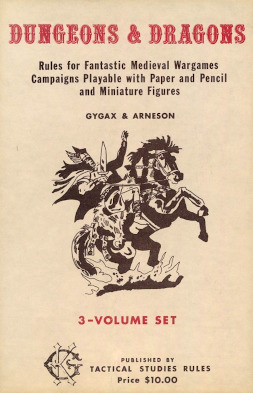
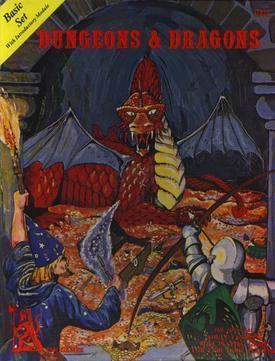






#dungeons and dragons#ttrpg#rpgs#dungeonsanddragons#d&d#thoughts#tumblr polls#my polls#polls#poll time#dnd#dnd5e#dungeons & dragons#od&d#D&D basic set#Basic D&D#ad&d#1e#ad&d 2e#advanced dungeons & dragons#d&d 2e#d&d 3.5#D&D 3e#d&d 4e#d&d 5e#d&d 5th edition#adnd#poll#random polls#tumblr poll
15 notes
·
View notes